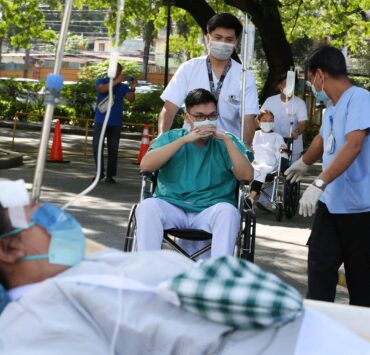Marcos declares nat’l calamity ahead of possible supertyphoon

President Marcos on Thursday declared a state of national calamity following widespread damage wrought by Typhoon “Tino” (international name: Kalmaegi) just as potential Supertyphoon “Uwan” (Fung-wong) is forecast to enter the country during the weekend.
Uwan was located as of Thursday outside the Philippine area of responsibility (PAR), 1,985 kilometers east of northeastern Mindanao. It was moving westward at 20 kilometers per hour before shifting west-northwest toward PAR.
Weather bureau Philippine Atmospheric, Geophysical and Astronomical Services Administration (Pagasa) said its landfall over the Philippine landmass was “becoming more likely.”
“Because of the scope of the problem areas that have been hit by Tino and will be hit by Uwan, there was a proposal from the National Disaster Risk Reduction and Management Council (NDRRMC)—which I approved—that we will declare a national calamity,” the President told reporters after presiding over a situation briefing at Camp Aguinaldo in Quezon City.
“Because many regions have been affected, almost 10 regions, and 10 to 12 will be affected by Uwan, …if that many areas are involved, with that kind of scope, then it’s a national calamity,” he added in a mix of Filipino and English.
‘Anticipate well’
The proclamation of a national calamity will enable government agencies to draw from emergency funds and fast-track the procurement of essential goods and services for typhoon victims.
While government efforts are ongoing to assist those affected by Tino, Mr. Marcos said preparations were underway for the potential impact of Uwan.
“Of course, we won’t leave Cebu until everything is in place. It’s the same thing—we’ll do as much as we can to anticipate. Because if we anticipate well and prepare well, we can do a lot to lessen the impact,” he said.
As of Thursday, the NDRRMC confirmed at least 66 deaths, 26 missing, and over one million individuals affected nationwide.
On the other hand, based on information gathered by the Inquirer from local disaster response officers and government units, the death toll from Tino was already at 150 as of Thursday.
Tino’s rainfall
Explaining the storm’s impact, Pagasa said Tino had unleashed a once-in-20-year rainfall across the Visayas, submerging towns and destroying homes and utilities, making it one of the year’s most destructive weather events.
The weather bureau said it dumped “exceptionally intense and sustained rains,” with 24-hour rainfall totals reaching 428 millimeters in Bagakay, Toledo City, 300 mm in Ilihan, Toledo, and 183 mm each in Danao and Mactan on Monday.
“These values exceeded the 20-year return period,” Pagasa said in a report on Wednesday, which indicates that such rainfall is statistically expected only once every two decades.
The slow-moving rainbands of the typhoon overwhelmed rivers and drainage systems, causing flash floods that submerged homes and farmlands just hours after landfall in Southern Leyte.
Entire communities were trapped as floodwaters rose rapidly, forcing rescuers to navigate waist-deep waters to reach stranded residents.
Cebu recorded the heaviest casualties with 93. In Negros Island, 57 people were confirmed dead and 67 remained missing: 53 in Negros Occidental and 14 in Canlaon City, Negros Oriental.
Dispensed funds
Palace press officer Claire Castro said the Office of the President has released P760 million in direct aid to the affected provinces and cities.
The dispensed funds are broken down into the following: P50 million (Cebu, Capiz, Surigao del Norte, Iloilo, Bohol, Negros Occidental), P40 million (Eastern Samar, Surigao del Sur, Southern Leyte, Antique, Aklan), P30 million (Leyte, Masbate);
P20 million (Guimaras, Agusan del Norte, Dinagat Islands), P10 million (Biliran, Camarines Sur, Sorsogon, Misamis Oriental, Negros Oriental, Palawan), P5 million (Albay, Batangas, Northern Samar, Siquijor, Quezon, Samar, Agusan del Sur, Laguna, Zamboanga City, Camiguin, Occidental Mindoro, Camarines Norte, Zamboanga del Norte, Iligan City, Romblon, Manila).
Brace for impact
As affected areas continued to assess Tino’s impact, the Department of the Interior and Local Government (DILG) on Thursday urged local governments to prepare for Uwan.
It ordered local governments to inspect roads and bridges, clear waterways and drainage systems, and stockpile relief supplies in anticipation of widespread flooding and landslides.
“We cannot be caught off guard. LGUs must take all precautionary steps now—activate disaster councils, prepare evacuation sites, and warn at-risk communities,” the DILG said in a statement.
Philippine National Police acting chief Police Lt. Gen. Jose Melencio Nartatez Jr., meanwhile, commended the Cebu Provincial Police Office (CPPO) for using drone technology to improve traffic and public safety operations in the aftermath of Tino, underscoring the growing role of technology in disaster response. —WITH REPORTS FROM LUISA CABATO, ZACARIAN SARAO, HAZEL P. VLLA, JOEY A. GABIETA, GERALDFORD TICKE AND GABRYELLE DUMALAG





















